- Cultural
influences on and evolution of food in Kolkata And a list of Best Restaurants in
Kolkata that serve Bengali, Haka Chinese, Mughlai, Marwari, Punjabi, Gujarati,
Tamil and Continental cuisine.
Food and the
Bengali are never too far away. And so, it was a long dream of mine to present
a guide to the best eating places in Kolkata. Here is my attempt as a guide to
a culinary galaxy.
After almost 200 years
of evolution, the cultural influences of Kolkata are five cuisines i.e. Bengali
or Bangla Ranna, Mughlai, Awadhi, Chinese, Rest of India and Continental and Anglo-Indian
Cuisine.
A major cultural
influence of Bengali cuisine is widows cooking, driven by the strict monastic
routine of widows who lost their aged husbands at a young age. This
paradoxically gave rise to a wealth of cookery, using only certain vegetables
and eschewing the usage of onions and garlic. Even thirty years ago Bengali
cuisine was strictly confined to the household kitchen. With time, things have
changed. There are many restaurants serving Bengali food – driven by influences
both from West Bengal and Bangladesh.
Another major
aspect of food philosophy in Bengal is the mixing of all flavours and the
gradual progression of a meal from bitter to sweet. No food is wasted and
local, seasonal produce is consumed as much as possible. The composition of the
menu varies with the weather and calendar at all times.
The best Bengali
restaurants in Kolkata today are Aaheli, 6 Ballygunge Place, Oh! Calcutta and
Kewpies. (run by the scion of the Dasgupta family, food connoisseurs for years).
At the middle end,
there are value for money chains like Bhajahori Manna, Sholo Anna Bangali and
Saare Chuattar. At the lower end are hotels which offer wholesome meals for as
little as Rs 10, comprising rice, dal, vegetables and fish curry. Such hotels are
found in suburban railway stations and the court premises at Alipore Judge
Court and Police Court.
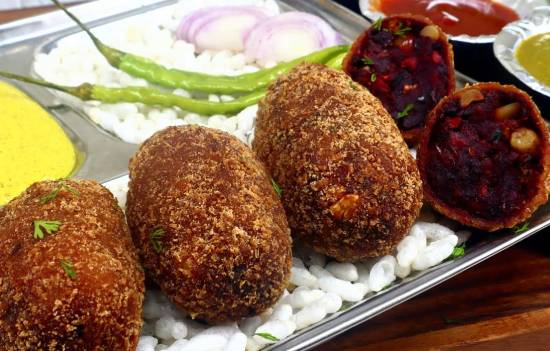 Chop cutlet
Chop cutlet
Included in the
gamut of Bengali cuisine is the street food and jalkhabar (mini meals) which are evening snacks. A major aspect of
Bengali cuisine is deep frying in mustard oil, which has led to the ‘chop
cutlet and roll’ sub culture of Bengali street food. The Bengali has always
thrived on adda where the cup of
Darjeeling/ Assam/ Dooars tea needs snacks and accompaniments. This has led to
a variety of much loved fried snacks such as fish fry, fish fingers, vegetable
chop, chicken cutlets, mutton chops, prawn cutlets.
Another much loved
snack is the Mughlai Paratha
(pronounced porota by Bengalis) which is similar to the Turkish gozleme. Anadi
Cabin off Esplanade is synonymous with Mughlai Paratha for years. The Kosha Mangsho (Pot roasted mutton) of
Gol Bari (Shyambazar) is now a brand name in itself, served with plain paratha.
A big item of jalkhanar is ghugni
(curried chickpeas at times served with mutton mince). Unlike its Punjabi
cousin, it is non vegetarian at will and served with toast or paratha.
The profusion of cabins (essentially private dining rooms for families with wooden partitions) set up in the early 1900s in North and Central Kolkata are storehouses of culinary excellence. It would be right to mention the names of Mitra Cafe and Dhiren Cabin (Sovabazar), Allen’s kitchen (known for its prawn cutlet deep fried in ghee), Barua and De (off Khanna cinema in Shyambazar noted for its Pantaras or Pan rolls), Niranjan Agar (off Girish Park). It would be also worthwhile to mention the name of Dacres Lane off Esplanade, which evolved as a street food hub over eighty years. One of the most celebrated hubs belonged to Chitta Babu whose stew and toast was legendary and prized by Anglo Indian secretaries for their light yet nourishing mid-day meals. Likewise in South Kolkata, the name of Bijoli Grill was synonymous with high quality fish fry and fish fingers.
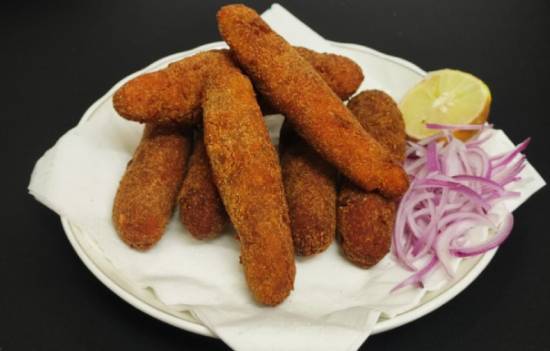 Fish Fingers.
Fish Fingers.
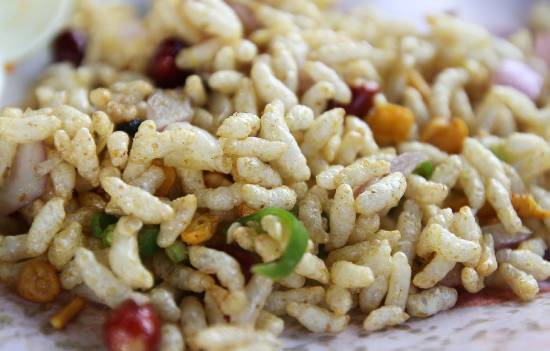 Jhal Muri.
Jhal Muri.
Street food is also part of the repertoire of Bengali cuisine. The humble jhal muri has also become part
of the adda culture, a value for money paper bag of diverse flavours, fully
vegan and now called instant food. Vivekananda Park in South Kolkata has
evolved as a hub for street food – whether jhal muri, bhel puri, phuchka (also
called golgappa and panipuri) and papri chat. Another chaat hub is opposite
Victoria Memorial in the maidan and off Vardan Market in Camac Street mainly
for North Indian Street food.
One cannot leave
the discussion without touching upon the roll. The ROLL evolved from a basic snack into a mini meal
with a simple structure – a paratha freshly mixed with dough and shallow fried
on a griddle, then filled with diverse fillings such as vegetables, paneer,
egg, chicken and mutton before being topped with masalas and sauces. As its
international cousins the Doner Kebab and Shawarma have evolved in Germany,
Turkey and the Middle East, the roll has evolved as a brand ambassador of
Kolkata.
The best rolls are
found in Nizam (off New Market), Badshah (one of the original creators of the
roll), Hot Kathi roll and Kusum (Park Street). The South has also evolved as
roll hotspots with Campari (Gariahat), Bedwin and Bawarchi (at Gariahat
crossing). Competition in Rolls is probably the toughest in the Kolkata
Gastronomic circuit. With time and inflation, the cost of rolls has gone up
from Rs 5 in 1989 to Rs 15 in 1999 to Rs 50 today.
The conquest of
Bengal by Islam left an indelible footprint of Muslim cooking style and
process. Communal eating, evolution of mini meals and diverse culinary
influences from Turkey, Iran, Yemen, Afghanistan marked the onset of Muslim
cooking. The fusion of Muslim and Hindu cooking
resulted in vegetables and meat which became part of Kolkata cookery.
The advent of Muslim culture and Nawabi court etiquette (known as Adab Kayda in
Urdu) started with the bustling cities of Murshidabad and Dhaka in the early
1700s, followed by the exiled king of Awadh Wajid Ali Shah in 1856. The
riverfront of Metiabruz (literally mud fort) was transformed into a
mini-Lucknow. The food of Lucknow now came into Kolkata.
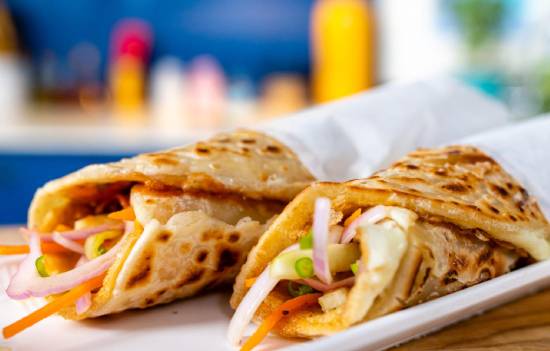 Roll.
Roll.
Mughlai
Cooking
After Wajid Ali
Shah’s death in 1887, many of the Khansama’s and Rakabdar’s set up their own
eating places. Today, Kolkata is known as a hot spot of Mughlai and Awadhi
cooking. The most popular dish must be Biryani – a dish of chicken/ mutton
cooked with rice. The best places are Shiraz (off Mullick Bazar), Aminia (New
Market), Arsalan and Zeeshan (Park Circus), Manzilat (behind Ruby Hospital).
Some quixotic names like Dada Boudi Biryani (Barrackpore) abound.
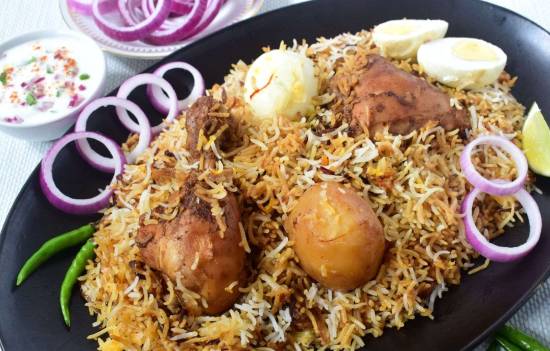 Biryani with Aloo
Biryani with Aloo
The differentiator
of Kolkata Biryani is the humble Aloo
which absorbs all the flavours of the meat broth. Other famous restaurants are
Royal (Chitpur with specialization in Chicken Chaap), Shabir (Esplanade with
specialization in Rezala), India Restaurant (Kidderpore with specialization in
Biryani and Galouti Kebab). In each of these restaurants, the preparation of
the dish is through a time-honoured process which is closely guarded. It is not
unusual to see three key tasks in any restaurant: Preparation of fresh atta for
making Naan/ Sheermals, mass chopping of onions for making thick gravy and preparation
of fresh ginger garlic paste in any Muslim eatery. A recent entrant into the Mughlai
restaurant scene has been Oudh 1590.
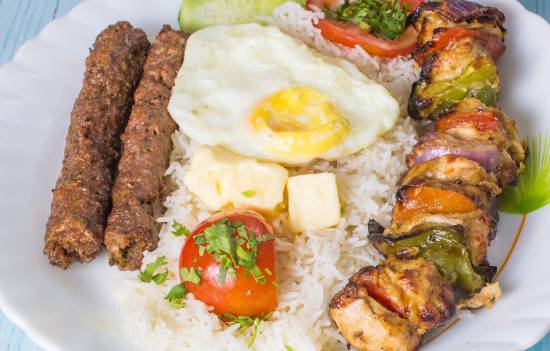 Chelo Kebab.
Chelo Kebab.Hakka Chinese
The evolution of
Kolkata to a trading outpost led to the entry of one of the most enterprising
communities–the Hakka Chinese. The first settler into Kolkata was Yong Atchew.
Gradually a vibrant Chinatown evolved in Kolkata. The philosophy of Chinese
food was usage of almost everything be it vegetables, chicken, mutton to pork. The
mastery of boiling oil in a wok is something which only the Chinese have
mastered, and starting the meal with green tea and ending with fortune cookies.
With time a unique
version of Kolkata Chinese has evolved. Chinese cuisine in the form of Fried
Rice, Hakka Noodles, American Chopsuey, Chilli Chicken and Garlic Pork has now
become staple for the foodies of the city. The rest of India also has adopted
Chinese food from the 1970s.
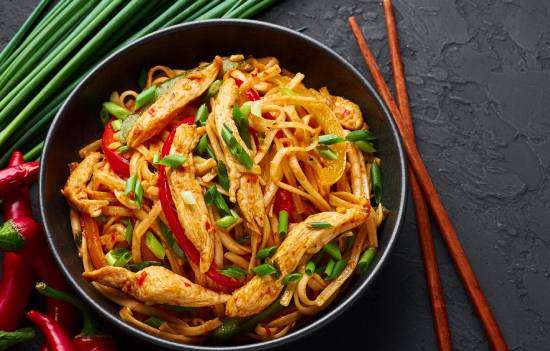
The
best restaurants are Eau Chew (off Central
Avenue and known for Chimney Soup as well as Josephine Noodles), Chung Wah
(same locality), Waldorf and Bar BQ (Park Street), Tung Fong (Free School
Street).
Over the last 15
yrs, many Chinese Restaurants have evolved in South Kolkata too. Mainland China
has now evolved as a chain all India and is represented in malls and Gurusaday
Road in the posh Ballygunge area. The top end is dominated by global chains
Hakkasan and Yauatcha who have made a fine art of Edamane and Dim Sums. Basic
momos with fiery sauces are available at Suburban Hospital Road, where Hamro
Momo is a steady name for 30 yrs.
Pan
Asian
Pan Asian has been
slow to take off, but Tom Yam finds takers for its hot spiciness, as does Tom
Kha for its comforting mellowness. The ubiquitous Red curry, Green curry,
Yellow curry, Panang/ Massaman curry, Satay have many fans. However, the big stars
of this food are Khow Suey and Mohinga.
The
best place to have these is a Buddhist temple (Central Kolkata)
with monks from Myanmar. Sushi, Teppanyaki and Tempura are finding gradual
takers too. But Kolkata remains a bastion of Chinese food, or specifically Indo
Chinese food!
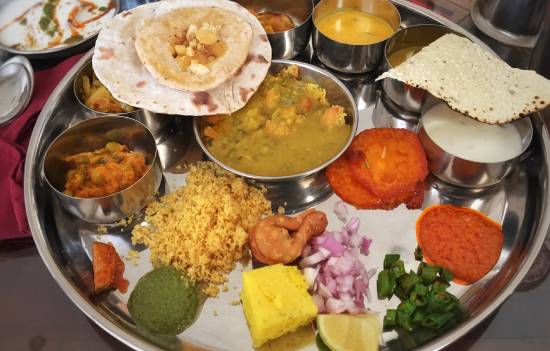 Thali.
Thali.
Marwari
cuisine
By the turn of the
20th century, the rail connectivity with the rest of India was
established. The first community to come to Kolkata were traders from
Shekhawati region in Rajasthan and were called Marwaris. They soon established
a stranglehold of business in the city in specific areas like jute. Crossing
the river, they made the erstwhile locality of Sutanuti their home and it soon
became known as Burrabazar. Marwaris adapted typical hardy root vegetables such
as sangria, gawarphali, keria and fogla as the staple vegetables.
Cooking was done
with liberal dosage of ghee, yoghurt and garam masala (a spice mixture
incorporating pepper, cinnamon, cumin, cloves, bay leaves and cardamom). The
dominant grains lent themselves to a variety of breads. Today, Marwari
restaurants are few but have given the city high portion of street food, vegetarian
meals and snacks. No Marwari meal is complete without papad and this has been
established in the citys culinary map as well.
Prominent
are Gangaur (Russell Street), Rajasthan Guest House
(Zakaria Street), Girnar (MG Road) and Pawan Putra (Beliaghata). It would be
also worthwhile mentioning the names of Vineet and Abhinandan (vegetarian fine
dining restaurants set up in the early 80s which are still remembered by the
gastronomes of the city). Amongst other communities from Rajasthan are the
Seharwali Jains who have adopted the vegetarian food of Bengal with joy and are
known for their fanatical love for Mangoes.
Punjabi
cuisine
The other
community which established itself in Kolkata were Punjabis. The Hindu Punjabis
established a stranglehold on the electrical goods market, while the Sikhs
dominated the transport sector. The pattern of a Punjabi meal was simple but
hearty. It started with a green salad and then went to a thick black dal,
wholesome multi grain roti and ended with a tall glass of lassi spiked with
salt and sugar.
The
first Punjabi restaurants were Ballygunge
Dhaba (1939), Amber (off Bentinck Street 1942), Bachan Dhaba (near Gurudwara
Jagat Sudhar) and Azad Hind Dhaba (Ballygunge Circular Road). Post
independence, the Ghai family set up Kwality Restaurant in Park Street which
became a standard for North Indian food. Gradually, the all-India empire of Ice
Creams and Restaurants set up by the Ghai and Lamba families became known for
good naan, butter chicken and malai kulfis.
Gujarati
and Tamil cuisine
It would be also
worthwhile mentioning Gujarati and Tamil cuisine, which has given the city some
amazing cuisines. The entire gamut of vegetarian cocktail snacks has come from
Gujarat, who have made the city their own from far off Saurashtra, Kutch and
Palanpur. The tea and timber trade are entirely the preserve of the Gujarati
community.
Saurashtra
Namkin House (Southern Avenue), Anna Ras (Shakespeare Sarani) and
Annapurna (Elgin Road) are known for their high quality Dhokla, Khakra, Theplas
and a variety of chivda and bhujia.
Likewise, South
Indian vegetarian food finds an all-India market with the ubiquitous Idli,
Dosa, Utthapam and meals. One can name the erstwhile South India club
(Hindustan Park 1926) as one of the pioneers of good tiffin and meals. Other big names are Raj (Bhowanipur), Banana Leaf
(Lake Market) and Jyoti Vihar (Harrington Street). Another well known name is
Rao Udipi (Lake View Road) operating since 1969.
Continental Food
The last to come
in were the British in 1757 and it was they who gave rise to the Continental
style of cookery. The Sahibs mixed their bland food with local produce. And so,
dishes like Mulligatawny soup, Chicken Clear soup, French Onion Soup, Sauteed
vegetables, mashed potatoes, grilled chicken, pork chops, mutton stew, fish
meuniere (fish with a thin coating of flour grilled to perfection) and of
course great desserts like souffles, caramel custards and parfaits – gradually
entered the Kolkata food scene by the 1900s.
A unique evolution
was Anglo Indian cooking, with incorporation of local spices and western
culinary practices. Typical dishes were yellow rice, mutton koftas, pan rolls, railway
chicken curry and unique dishes like kedgeree (a derivative of the Bengali
khichuri), chutney. While local ingredients were used, the redeeming feature of
Anglo-Indian cuisine was the etiquette and pomp of ‘propah’ British food.
Amongst the most popular
dishes in Kolkata is Chelo Kebab–an
offering from Iran dating back to Firdousis era. The best place for Chelo Kebab
is Peter Cat in Middleton Row.
Other
good continental restaurants are Mocambo. Many names have faded away but still draw gasps of wonder: Blue Fox, Moulin Rouge and Skyroom (shut down in 1993) Amongst the newer names are Corner Courtyard (Maddox Square), Chapter 2 (Southern Avenue), Café Mezzuna (Elgin Road) and Chilis (serving modern American food in malls). A host of cafes serving new age continental have also come up in Southern Avenue.
Kolkata
Clubs
Kolkata has had a
big club culture. Amongst the well-known clubs are Royal Calcutta Golf Club, Tollygunge
Club, Calcutta Club, Bengal Club, Saturday Club, Calcutta Swimming Club and the
rowing centric Lake Club, Calcutta Rowing Club. Some club dishes like smoked
Hilsa (the original recipe came from Myanmar in 1826 courtesy Mogh cooks) are
legendary but run the risk of being lost. Calcutta Club used to be known for
rice crispy soup (nowadays rare to get). The club culture in Kolkata is one of
the biggest attractions in the country.
Bars
Kolkata has always
been the haunt of the serious drinker, not the pub crawler. There are the
famous bars like Saqi (Dharmatala), Tripti (Bhowanipur) which are great places
for adda over a glass of whisky and basic snacks like salted peanuts, juliennes
of ginger and shallots in vinegar. Then come the legendary Olypub on Park
Street which serves good steaks with the usual Royal Challenge and Old Monk. In
1994, Kolkata got a great venue for live music in Someplace Else – part of Park
Hotel. Of late, the Broadway Hotel (Ganesh Chandra Avenue) is a great place for
drinks, snacks, pub food and some amazing live music.
Many newer pubs
have come up with upmarket offerings for drinks and snacks, but the ambience of
an older pub in a 1930s art deco building is something difference. Trincas in
Park Street has had a great history in live music, spawning acts like Usha
Uthup, Pam Crain, Louis Banks and initially Biddu who went on to make a name
for himself internationally in the 1970s.
The average mortality
rate of restaurants is around 85-90% so a restaurant is not expected to last
more than a year. However, most of the restaurants mentioned are long lived. Am
sure that the essential food culture and the philosophies mentioned will
sustain and flourish into the future. And so, the foodie continues to salivate
in the culinary galaxy.
Acknowledgements
Mr Sujoy Roy
Choudhury, SXC batch 1986
Mr Soumitra
Chatterjee, SXC batch 1986
Mr Neelkanth
Chatterjee, SXC batch 1986
Ms Chandrima Roy
Ms Jaya Ganguli
The Calcutta
Cookbook, Minakshie Dasgupta and Jaya Chaliha
The Calcutta
Kitchen, Chef Udit Sarkhel
Rannar Boi, Lila
Majumdar
Anjums New Indian,
Anjum Anand
Indian Food: A
historical companion, KT Achaya
Author, Kaushik Ganguli is a Fellow Chartered Accountant cum Management Accountant with 28 yrs experience in Corporate and Entrepreneurship. He is now a Professional Counsellor cum Career Mentor running his own company, a bestselling author and a long standing resident of Kolkata. He is also a foodie with exposure to local, national and global culinary trends.
Also read Best Places to eat in
1. Guwahati
2. Amritsar
3. Jaipur
4. Things
to eat in Lucknow during Winters
5. Indore
is a great place for street food